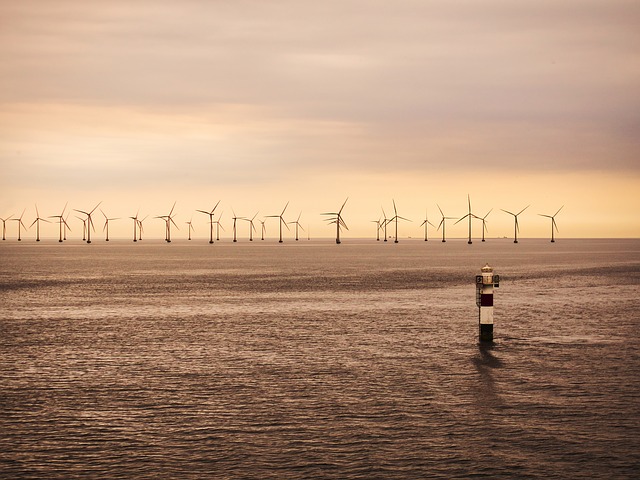October 11, 2018
By Shay O’Reilly
National Sierra Club Beyond Coal Organizing Representative, New York City
 About ten minutes’ walk through a modest, tree-lined neighborhood, visitors to Copenhagen’s Amager Strandpark reach a pedestrian bridge that faces the sound between Denmark and Sweden. Beyond: a park of rolling dunes with a spectacular view, to the north, of a row of wind turbines anchored in Copenhagen harbor.
About ten minutes’ walk through a modest, tree-lined neighborhood, visitors to Copenhagen’s Amager Strandpark reach a pedestrian bridge that faces the sound between Denmark and Sweden. Beyond: a park of rolling dunes with a spectacular view, to the north, of a row of wind turbines anchored in Copenhagen harbor.Though they’re closer to shore and smaller than modern turbines, when I saw these in 2017, I was delighted — I’d been working for the Sierra Club’s Beyond Coal Campaign for almost a year, with offshore wind as the most important component of my organizing.
Offshore wind is a critical renewable energy technology for ending our reliance on fossil fuels, especially in downstate New York. It produces large-scale, consistent power, utilizing the wealth of wind resources off our coast, closest to areas of peak demand. The steady wind speeds, combined with a relatively shallow ocean floor, make New York’s Atlantic shelf a global hotspot for offshore wind. Advocates, including the Sierra Club, have been leading the charge to bring this European technology home for decades. Now, after years of campaigning and organizing, huge momentum has led to significant support from New York State for offshore wind, and a powerful coalition of business, environmental, labor and environmental justice organizations back its development.
Our state’s first offshore wind project, Deepwater Wind’s South Fork Wind Farm, got a final transmission line permit from the Town of East Hampton this summer and intends to produce power by 2022. This 90MW farm will power over 45,000 homes on the east end of Long Island, meeting projected demand with no need for fossil fuels — and at a cost cheaper than any other technology, renewable or fossil.
For the next projects, the New York State Energy Research & Development Authority (NYSERDA) has sketched out how offshore wind expansion could look in our state. Its Offshore Wind Master Plan, available on NYSERDA’s website, has a series of studies on mitigating impacts to wildlife, connecting wind farms to the grid, maximizing local workforce potential and possible ports for industrial use.
The Sierra Club has been committed to ensuring that offshore wind is developed responsibly. Along with advocating for the expansion of offshore wind, we have advocated for strong labor standards, community benefit agreements and environmental protection. Over 50 organizations statewide signed on to a Club-led letter requesting that NYSERDA establish responsible contracting standards for offshore wind. As the state establishes how offshore wind will be procured, it also has the power to insist that we build this new energy system with economic and ecological justice. The Block Island Wind farm was built with local organized labor and any project in our state should mirror this.
People concerned about offshore wind often cite possible impacts on birds, fish and/or marine mammals. It’s critical that offshore wind is responsibly sited to minimize effects on these parts of our ecosystem, and we’ve seen that developers are very willing to undertake such mitigation measures. The Block Island Wind Farm, our country’s first, employed people to watch for whales and halted construction during the whale migration. Of course, climate change remains the single greatest threat to all creatures, a fact recognized by the National Wildlife Federation in its support for offshore wind.
So what’s next for offshore wind in New York? Our state has committed to sourcing 800 megawatts (MW) of offshore wind in the next two years, as part of its 2,400MW goal by 2030, and is currently defining contracting requirements for that procurement. Meanwhile, New York has also asked the federal Bureau of Ocean Energy Management to designate new lease areas off our coast for offshore wind development, a process that (fingers crossed) Secretary of the Interior Ryan Zinke has signaled he supports and is critically necessary to ensure that New York hits its targets.
Job and economic studies conclude that the states that are the first movers at scale to invest in ports and other infrastructure will not only gain the majority of the supply chain but will ensure long-term, family-wage careers in building offshore wind. New York should invest in ports and other staging infrastructure, and be a regional hub for the industry, thereby multiplying and maximizing jobs, manufacturing and increased economic development for New Yorkers.
If our state’s plans move forward — backed by organizations like the Sierra Club, National Wildlife Federation, UPROSE, the Long Island Federation of Labor and the construction trades — we will soon be able to board a boat and see huge, beautiful spinning turbines that cleanly and safely power downstate New York.